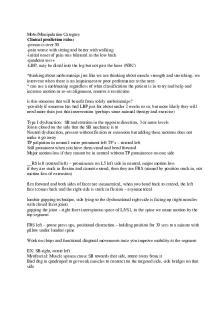EE273 - lecture 05-long PDF

| Title | EE273 - lecture 05-long |
|---|---|
| Author | James Smythe |
| Course | Engineering Design For Software Development 2 |
| Institution | University of Strathclyde |
| Pages | 23 |
| File Size | 1000.6 KB |
| File Type | |
| Total Downloads | 19 |
| Total Views | 139 |
Summary
Lecture Notes for 5th lecture...
Description
EE273/985
Lecture 5 Arrays and memory allocation
Dr David Harle Dr Christos Tachtatzis EE273/985 – Engineering For Software Design
©University of Strathclyde & C. Tachtatzis, D. Harle, K.Bell
1
This Section
o Arrays •
Declaration, initialisation, access elements
•
Use in loops
o Arrays as arguments in functions o Dynamic memory allocation o Brief introduction to pointers
EE273/985 – Engineering For Software Design
©University of Strathclyde & C. Tachtatzis, D. Harle, K.Bell
2
What is an array? Arrays: variables that can memorize multiple data and stored sequentially in numbered array’s elements. So far, you have encountered variables that can only store a single piece of data (lecture 2)
In C++, indexing of the elements starts at zero . Think of an array as a set of variables e.g.
X is the name of the array variable and the indices are which unit of the train you want to work with, so X[1] is the box marked 1.
EE273/985 – Engineering For Software Design
©University of Strathclyde & C. Tachtatzis, D. Harle, K.Bell
3
What is an array? Properties: •
The individual data items in the array are called elements. •
•
All elements are stored contiguously in the computer’s memory •
•
All elements must be of the same data type.
In C and C++, the index of the 1st element is zero.
What is stored against the name of the array is actually the address of the first element of the array. Important! • •
What is stored is a pointer to the start of the array
The number in the [ ] is an offset in memory from that first location
EE273/985 – Engineering For Software Design
©University of Strathclyde & C. Tachtatzis, D. Harle, K.Bell
4
Array declaration To declare such an array int X[6];
in the same way as normal variables except the size of the array must be specified in the declaration, in square brackets after the array name
This declared a variable X that holds an array of 6 values. X has 6 spaces in the array. • •
First element is X[0] Last element indexed X[5]
In this case, the 6 places can only be filled with integer numbers. EE273/985 – Engineering For Software Design
©University of Strathclyde & C. Tachtatzis, D. Harle, K.Bell
5
Allocating values to elements in an array X[2] = 8; This means set X at position 2 (3rd element of the array) to the value 8
0 1 2 3 4 To declare a two dimensional array myarray[][]
int myarray[3][6];
0
myarray
1 2 0
1
2
3
EE273/985 – Engineering For Software Design
4
5
Row offset
How would you set the element in the 2nd row and 5th column of the 2D array to a value of 10?
myarray[1][4] = 10 ; y of Strathclyde
Column offset
arle, K.Bell
6
Why use an array?
If we would like to store and add the scores for this course: float assignment1, assignment2, assignment3, assignment4, total_marks; total_marks = assignment1 + assignment2 + assignment3 + assignment4;
EE273/985 – Engineering For Software Design
©University of Strathclyde & C. Tachtatzis, D. Harle, K.Bell
7
Why use an array? o Alternatively: st float assignment[4],total_mark The 1 element is has index 0 total_marks=assignment[0]+assignment[1]+as signment[2]+assignment[3]; o Or using loops: Don’t forget to initialise the total_marks = 0; accumulator! for(i=0;i...
Similar Free PDFs

EE273 - lecture 05-long
- 23 Pages

EE273 - lecture 03-long
- 30 Pages

EE273 - lecture 02-long
- 40 Pages

Lecture notes, lecture 3
- 5 Pages

Lecture notes, lecture Subspaces
- 21 Pages

Lecture notes, lecture 14
- 3 Pages

Lecture notes, lecture 6
- 3 Pages

Lecture notes, lecture 7b
- 4 Pages

Lecture notes, lecture 13
- 12 Pages

Lecture notes, lecture 12
- 9 Pages

Lecture notes, lecture all
- 62 Pages

Lecture notes, lecture 25
- 44 Pages

Lecture notes, lecture All
- 273 Pages

Lecture notes, lecture 1
- 9 Pages
Popular Institutions
- Tinajero National High School - Annex
- Politeknik Caltex Riau
- Yokohama City University
- SGT University
- University of Al-Qadisiyah
- Divine Word College of Vigan
- Techniek College Rotterdam
- Universidade de Santiago
- Universiti Teknologi MARA Cawangan Johor Kampus Pasir Gudang
- Poltekkes Kemenkes Yogyakarta
- Baguio City National High School
- Colegio san marcos
- preparatoria uno
- Centro de Bachillerato Tecnológico Industrial y de Servicios No. 107
- Dalian Maritime University
- Quang Trung Secondary School
- Colegio Tecnológico en Informática
- Corporación Regional de Educación Superior
- Grupo CEDVA
- Dar Al Uloom University
- Centro de Estudios Preuniversitarios de la Universidad Nacional de Ingeniería
- 上智大学
- Aakash International School, Nuna Majara
- San Felipe Neri Catholic School
- Kang Chiao International School - New Taipei City
- Misamis Occidental National High School
- Institución Educativa Escuela Normal Juan Ladrilleros
- Kolehiyo ng Pantukan
- Batanes State College
- Instituto Continental
- Sekolah Menengah Kejuruan Kesehatan Kaltara (Tarakan)
- Colegio de La Inmaculada Concepcion - Cebu

